Matador Network's Blog, page 732
December 11, 2020
Most beautiful yurts to rent

Traditional houses and apartments are all good and well, but why would you rent something banal when you can make your vacations more exciting by booking a treehouse, a log cabin, or even a haunted property? According to a trend report by Airbnb this fall, travelers are so keen to experience new types of accommodations that unique stays like tiny homes, barns, and even caves are “overtaking traditional options in trip searches” on the platform. To make sure you get on the action and get a much-needed dose of escapism in the process, opt for an out-of-the-ordinary Airbnb by renting a yurt.
A circular piece of architecture, yurts originate from Asia, but have become extremely popular in the West as homes and rentals. Yurts traditionally consist of a wooden structure covered by material and are movable, a little like a large tent would, but they are sturdier and offer great weather protection.
We’ve selected the best yurts available on Airbnb this winter throughout the United States, from California to Kansas, Vermont, and more. While the yurts we have handpicked for your next vacation don’t necessarily match the criteria that makes them genuine, classic yurts, they will all transport you somewhere magical and keep you cozy for an unforgettable winter getaway.
1. “Yur-Treat” near Grand Teton National Park, Idaho
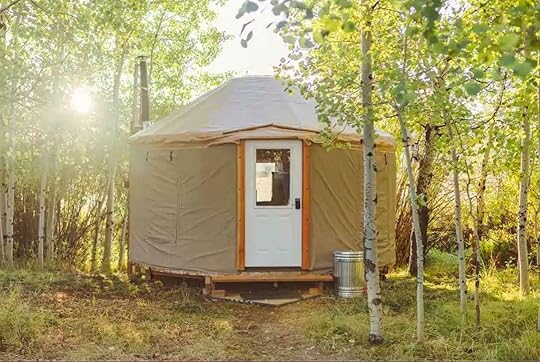
Photo: Airbnb
This small yurt can accommodate three guests in its one queen bed and one twin bed, but it’s better suited for a couple or a single person needing some serious peace and quiet. Built in a grove of aspen trees in Teton County, Idaho, the yurt has gorgeous views of the Teton Mountain Range and is close to Grand Teton National Park and the town of Jackson Hole.
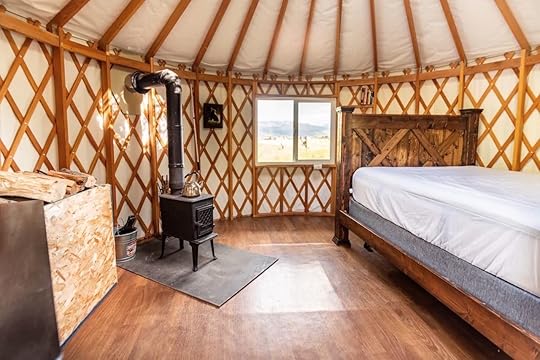
Photo: Airbnb
The yurt is secluded and off the grid, so there’s no running water or electricity, but there’s a wood stove (wood is supplied) to keep you toasty, two outhouses for a rustic bathroom experience, and an outdoor picnic table and a fire pit for a night of stargazing (if they are not buried in snow). In winter, make sure to bring warm clothing and bedding, as well as all the other essentials to stay fed, hydrated, and with light. There’s a creek running just outside the yurt for your use, but it will be frozen in winter so don’t expect a pleasant and refreshing dip in lieu of a shower.
2. Forest yurt for a nature retreat on Whidbey Island, Washington
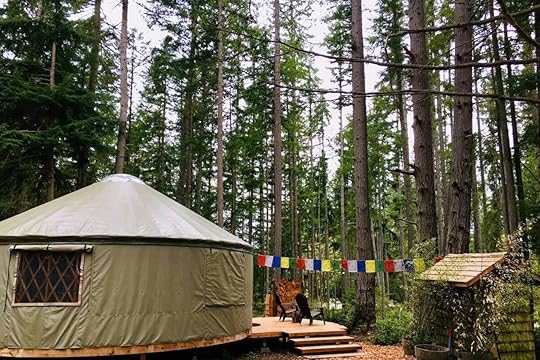
Photo: Airbnb
Vacationing on Whidbey Island is a surefire way to get away from it all. Add to this beautiful destination a stay in this yurt located in a forest of conifer, and you’re in for a serene escape in nature. Although it may look rustic at first sight, the yurt has a king-size bed and a fold-out couch that can sleep four people, as well as a small kitchen with running and hot water, an outhouse with a composting toilet, and an outdoor heated shower. The wood stove keeps the place warm and comfortable, and the yurt is well insulated and heated for year-round bookings.
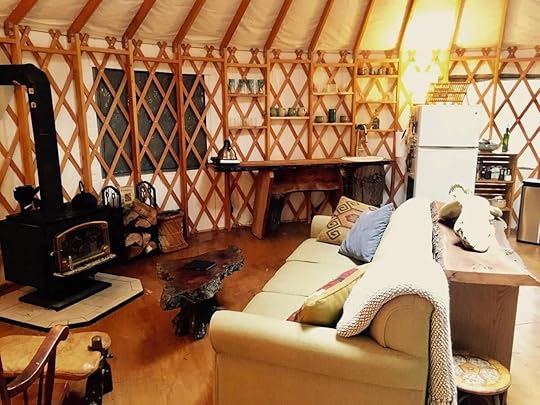
Photo: Airbnb
The site is very private and built on a 24-acre organic farmstead, so you won’t hear any traffic noise, but you’ll hear bird songs, farm animals, and the sound of wind and rain on the trees and the roof of the yurt.
3. “Stargazer Yurt” in Yucca Valley, California

Photo: Airbnb
This small yurt on 40 acres of desert land will provide all the tranquility one seeks. Free of light pollution, the site is the perfect spot to observe the night sky. There’s an outdoor fire pit and deck chairs to relax outside at night, catch the sunset, or look at the celestial bodies around you, but you can also see the stars through the yurt dome for a very cozy and romantic experience. During the day, lounge chairs set under a shaded structure among the Joshua trees will allow for a relaxing time.

Photo: Airbnb
There’s a modern shower, tub, and sink area outside with running, potable water, but there is no electricity in the yurt. Guests are provided with headlamps and solar lights. There’s an outdoor BBQ grill for all your cooking needs.
4. Off-grid Mongolian yurt in Kansas

Photo: Airbnb
Sun & Moon is a beautiful authentic yurt made in Mongolia out of wood, wool, and canvas. Far from Asia, today it is located in a forest setting in Lawrence, Kansas. Completely off the grid, the yurt has no electricity, no Wi-Fi, no running water, and no shower. You’ll be provided with candles and lanterns. There is an outhouse close to the yurt with a water basin and a composting toilet.
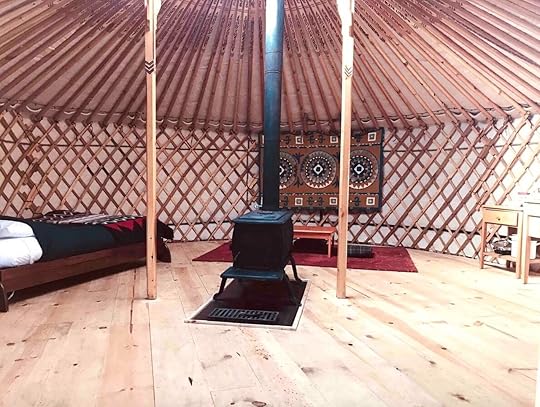
Photo: Airbnb
You’ll quickly forget the lack of modern conveniences upon seeing the beautiful front door and the stunning wooden interior decor. Inside, you’ll find a wood stove in the center of the yurt, as well as a double bed to accommodate two guests.
5. Four-season country yurt in Vermont
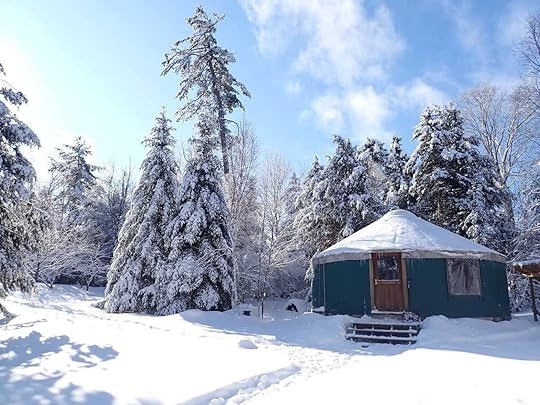
Photo: Airbnb
Only 10 minutes from Montpelier and close to several state parks (Little River, Groton, Camel’s Hump, and Mount Mansfield), this beautiful yurt can accommodate four guests on its queen-size bed and fold-out double futon. Located in a forest setting, the yurt is very private and peaceful — the only sounds you’ll hear are from the inhabitants of the forest.
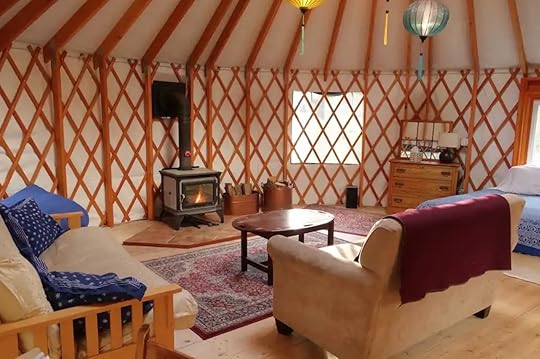
Photo: Airbnb
Inside, there is a soapstone wood-fire stove that the owners will light up before your arrival if you book the yurt in winter. Although the accommodation is very cozy, you’ll want to go out and explore the hiking, biking, and cross-country ski trails and swimming holes just outside your door. There is electricity in the yurt but there is no outdoor plumbing so guests use a portalet. Water is provided by the hosts for washing and drinking.
6. Hillside yurt in Utah
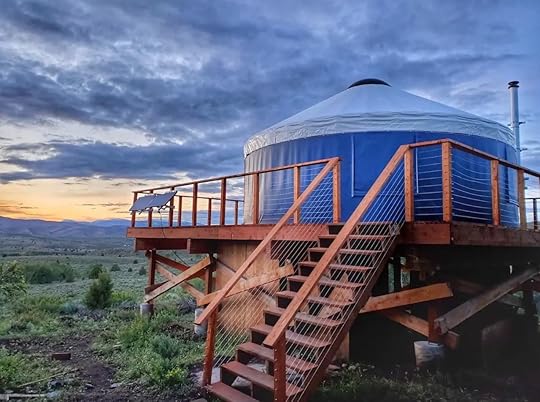
Photo: Airbnb
This large yurt is not a luxury accommodation, but the amazing setting is worth the primitive comfort. Because it can fit 10 guests on its two queen-size beds and six bunk beds, this no-frills, backcountry yurt is a great place for a weekend of outdoor adventures with a group of friends and family members. The wood-fire stove will make things very warm and comfy after a day spent on the many miles of trails nearby, whether that’s hiking, snowmobiling, snowshoes, or cross-country skiing.
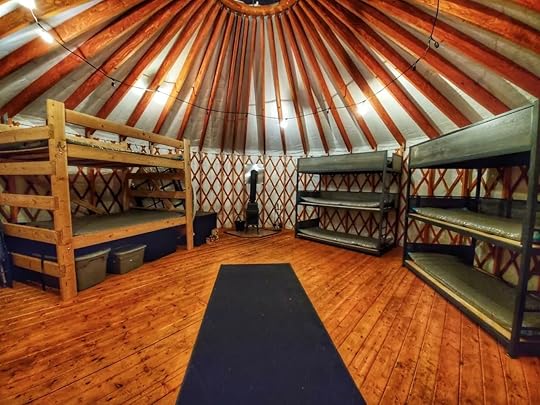
Photo: Airbnb
The yurt is surrounded by nature and wildlife, so, from the deck, you’re able to catch the sunset and look for the bull moose who live on the hill. There is no running water in the yurt so you need to bring your own for washing and drinking, but there is a kitchen with a stove for your cooking needs.
7. Luxury, romantic yurt in Texas
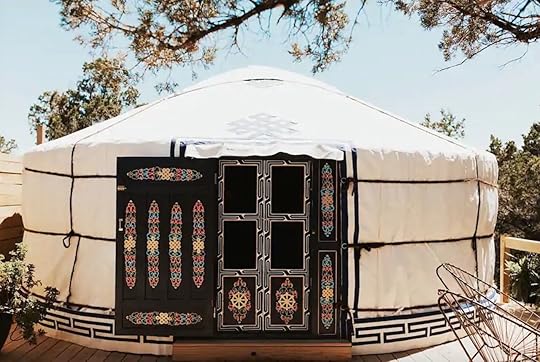
Photo: Airbnb
The best words to describe this yurt in Texas Hill Country are luxurious relaxation. Although it is an authentic Mongolian yurt, made of wood, sheep’s wool insulation, and horse hair ropes holding the structure together, it also has all the comfort of a fancy hotel. It is extremely private with views on the nearby woods, it has a hot tub, AC, heat, a gas fire pit, high-speed internet, an outdoor kitchen, private rooftop deck with a hammock and deck chairs, cable TV, and more.
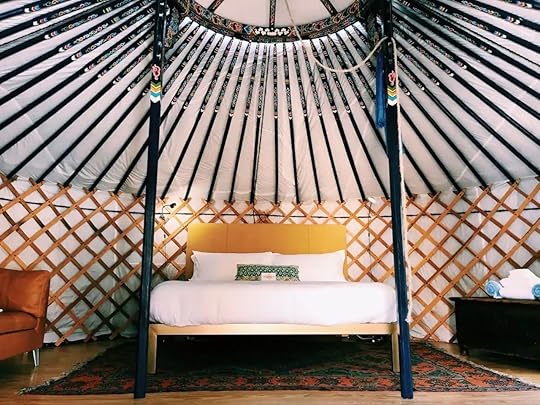
Photo: Airbnb
The private outdoor bathroom is as fancy as the stylish furnishings of the yurt, but it’s the traditional features of the structure that will please travelers the most. With its genuine Mongolian exterior canvas, highly decorated door, and wooden poles inside, you’ll be transported to Asia instantly. 
More like thisLuxury TravelThe 9 coziest Airbnbs in upstate New York
The post The 7 coziest yurts to rent on Airbnb in the US this winter appeared first on Matador Network.

Classic Hawaiian foods

Hawaii is famous for the freshness and bright flavors of its ingredients — culinary characteristics perhaps best embodied by one of its most iconic dishes: poke. This as-fresh-as-you-can-get, raw, diced, and lightly seasoned fish dish is of course worth trying in Hawaii, but there are so many other dishes native to Hawaii that deserve the iconic status poke enjoys among mainlanders.
The best Hawaiian food — from comforting noodle soup to spam sushi — is rooted in the islands’ rich multicultural heritage, and the dishes blend and embrace Japanese, Portuguese, Filipino, and indigenous flavors and ingredients. Other dishes are modern versions of ancient staple foods that incorporate Hawaii’s lush and abundant plant life. Hawaii’s culinary delights extend beyond fish and include canoe plants, international ingredients, and cooking techniques drawn from ancient Hawaii and its long plantation history.
“I like the fact that Hawaiian food, which was basically sustenance food in ancient Hawaii, has evolved over time and come into its own as really delicious and satisfying comfort food,” chef Keoni Chang, vice president of Foodland, Hawaii’s largest locally owned grocery store chain, tells me. “[And] a lot of items considered ‘luau food’ come from Hawaii’s ethnic diversity and history.”
Next time you’re in Hawaii, go ahead and try the poke, but also be sure to appreciate how diverse the islands’ cuisine really is. Here are 10 dishes to try in Hawaii beyond poke.
1. Saimin

Photo: JJava Designs/Shutterstock
Saimin is Hawaii’s answer to Japanese ramen. The simple dashi-based broth is topped with char siu (barbecue pork), green onions, and pink and white fish cakes called kamaboko, swimming among springy wheat noodles. An alternative version called wun tun min is topped with pork dumplings. Saimin is so popular and widespread that you can find versions at local 7-11 and McDonald’s in Hawaii.
The name is a combination of two Chinese words: sai (thin) and mein (noodles). However, the dish’s legacy is one of intermingling cultural influences. It first appeared in the 1800s in camps set up for laborers on Hawaii’s sugar and pineapple plantations (a similarity to several other dishes on this list). Chinese, Japanese, and Filipino workers ate lunch together, trading ingredients and flavors until eventually “saimin was born,” according to an essay in Life & Thyme.
Where to try: Palace Saimin, 1256 N King St, Honolulu, HI 96817
2. Spam musubi

Photo: Aloha Abroad/Shutterstock
This popular convenience store snack is much beloved throughout Hawaii as a portable, on-the-go treat that’s easy to pop in your bag. It’s made by sandwiching grilled spam between two square cakes of rice wrapped in nori.
There are conflicting reports regarding who exactly invented spam musubi, though most stories agree that the snack first emerged during World War II when nearly 120,000 people of Japanese descent were interned in camps following the attacks on Pearl Harbor. Interned families were likely eager to make an approximation of onigiri — a cylindrical cake of rice wrapped in nori that’s considered a beloved comfort food — with shelf-stable Spam.
Two different Japanese-American women are often credited with creating the modern version of spam musubi that we know today in the early 1980s: Barbara Funamura sold it from her restaurant Joni-Hana while another story claims that a woman named Mitsuko Kaneshiro first made them for her children before selling them out of a pharmacy in Honolulu until she was able to open her own shop.
Where to try: Musubi Cafe Iyasume, 334 Seaside Ave, Honolulu, HI 96815 (and other locations)
3. Haupia

Photo: Leigh Anne Meeks/Shutterstock
This dessert is made from coconut milk, sugar, and arrowroot (or cornstarch). Though it’s sometimes called coconut pudding, the consistency is firmer and bouncier, more like a cross between pudding and Jell-O. Traditionally, haupia is cut into small squares, chilled, and served plain. You’ll very likely find it served as a side accompanying Hawaiian plate lunch (more on that soon) and at lūʻaus. However, haipua is also added to pies and ice cream, mostly famously chocolate haupia pie, sometimes called a “dessert institution” in Hawaii.
Where to try: Anna Miller’s Restaurant, 98-115 Kaonohi St, Aiea, HI 96701
4. Poi

Photo: Eric Broder Van Dyke/Shutterstock
Several chefs agree that poi might be one of the most underappreciated foods in Hawaii. This ancient Indigenous Hawaiian staple food is made by pounding taro root into a purple paste on a traditional papa ku‘i‘ai, a wooden board, using a pōhaku ku‘i ‘a, a wooden pestle. Chef Jeremy Shigekane, the owner of M by Chef Mavro in Honolulu, argues that “outsiders don’t like the texture,” but that more people should “appreciate the labor that goes into such a simple dish.”
How poi is prepared and served often depends on who is making it.
“[People] look at it as a novelty, but I think the issue is that it’s served too thick,” Chang says. “I like my poi really cold. My great grandmother served it with ice cubes in it. We liked to eat it when it was three days old, when it started to sour. It had a really nice tang to it. My mouth is watering imagining fried fish, chili pepper water, and Maui onions with Hawaiian salt as a pairing with sour poi.”
Alan Wong, co-founder of the Hawaii Food Festival, has a similar preparation for poi: He tops poi with lomi lomi salmon and sprinkles chili pepper water on top. He also makes a poi stew with cubed beef.
“I think poi is misunderstood,” he adds. “The first time I ate it as a small kid, I thought it smelled like cigar smoke, and of course hated it. A lot of visitors think it’s like glue paste, but there are so many varieties of poi. It is very alkaline, and a good healthy product.”
Where to try: Waiahole Poi Factory, 48-140 Kamehameha Hwy, Kaneohe, HI 96744 (takeout only)
6. Shave ice

Photo: VDB Photos/Shutterstock
Locals and tourists line up for a taste of what might be considered Hawaii’s most iconic dessert: shave ice. Like so many other beloved Hawaiian foods, migrants who made their home on the islands are at least partially responsible for its proliferation. Japanese immigrants introduced their Hawaiian neighbors to kakigori in the mid-1800s, adapting the traditional Japanese dish to their new circumstances by shaving flakes off of large blocks of ice, then sweetening the concoction with sugar or fruit juice. Today, you can find shave ice flavors like lilikoi and pickled mango, and toppings like Japanese red beans.
Where to try: Matsumoto’s Shave Ice, 66-111 Kamehameha Hwy #605, Haleiwa, HI 96712
7. Loco moco

Photo: stockphoto for you/Shutterstock
Drawing inspiration from Japanese hambagu, loco moco might remind one of a disassembled hamburger served atop a bed of rice. Considered one of the island’s most iconic comfort foods, the dish consists of a hamburger patty doused in a soy-sauce-based gravy and topped with a runny sunny side up egg.
The urban legend behind the origins of the dish is fascinating and is linked to a crew of teenage boys from Hilo that was known locally as the Lincoln Wreckers and was renowned for its athletic prowess. They hung at the Lincoln Grill, and one day in 1949, being broke teens, they asked the owner to whip up a cheap but hunger-satiating meal on one of their many visits to the restaurant. In 2018, Dr. George Takahashi — a member of the Lincoln Wreckers at the time — related this tale to the East Bay Times, claiming that he and his friends came up with the name on a whim. The dish soon popped up on menus all over Hawaii. Takahashi admits that the Wreckers might not have been the first to think of the dish, but he insists they did come up with the name.
Where to try: Rainbow Drive-In, 3308 Kanaina Avenue Honolulu, Hawaii 96815 (and other locations; takeout only)
7. Luau stew

Photo: ChristopherMYa/Shutterstock
Voluptuous luau leaves — the leaves of the taro plant — take center stage in this hearty stew. Beef or pork, taro, and sweet potatoes are cooked with the leaves until they become dark green and soft, and then it’s served over rice or poi. The stew is typically cooked at home and doesn’t often appear on restaurant menus, which is one reason why Denise Yamaguchi — CEO of the Hawaiian Food Festival and Alan Wong’s colleague — says it might be underappreciated.
“Also, because it looks like green spinach soup, many who are not from here are turned off by the way it looks,” she adds. “But it’s actually really tasty and healthy, too.”
Chef Chang grows taro in his backyard, so he has direct access to fresh luau leaves, which makes preparing luau stew even more meaningful for him. His version includes beef short ribs and onions. “I love the texture and depth of luau leaves,” he says.
Where to try: Make it at home!
8. Plate lunch

Photo: Erin Donalson/Shutterstock
Served at street vendors and diners, plate lunch is a mainstay of Hawaiian culinary culture. According to Eater, it’s a multicultural descendant of “Southern meat-and-three plates.” Though the main dish can change, it’s always served with macaroni and cheese and two scoops of rice. Plate lunch reflects the multicultural heritage of the Hawaiian islands, incorporating flavors and dishes from Japan, China, the Philippines, Korea, and Portugal. For instance, the main dish might be kalua pork, chicken katsu, Spam musubi, or loco moco.
Plate lunch dates back to the late 1800s when it was an easy, inexpensive lunch for laborers on Hawaii’s pineapple and sugar plantations. The deceptively simple name comes from the fact that by the 1930s it came to be served on paper plates. The plantation era ended but plate lunch remained a staple on the islands, and you can now find versions of it on the mainland in places like California, Texas, and New York.
Where to try: L&L Hawaiian Barbecue, 1111-B Fort Street Mall Honolulu, HI, 96813 (and other locations)
9. Garlic shrimp

Photo: Follow2find/Shutterstock
This pungent, spicy shellfish rose to prominence thanks to the profusion of food trucks along Oahu’s North Shore. The shrimp are tossed in a mixture of paprika and cayenne, then dipped in garlic butter sauce and served on a Styrofoam tray with rice and a lemon wedge. The originator of the garlic shrimp trend was likely Giovanni’s Original White Shrimp Truck. The truck first began operating in the Kahuku area, known for its freshwater aquaculture farms, and the lines started forming. Today, there are still at least five prominent shrimp trucks parked on the North Shore that still enjoy bustling service.
Where to try: Giovanni’s, 66-472 Kamehameha Hwy, Haleiwa, HI 96712
10. Manapua

Photo: Nancy Kennedy/Shutterstock
This snack is almost identical to Chinese char siu bao, or steamed buns filled with pork. Chinese immigrants, who were hired to work on sugar and pineapple plantations, brought them to Hawaii in the 19th century. The nourishing and delicious snack proved so popular that Chinese workers began hawking them at camps set up for plantation workers. In the 1970s, these pork bun hawkers evolved into mobile vendors known as the Manapua Man. These vendors are still ubiquitous throughout the islands, but instead of selling their edible wares from baskets or carts, they set up shop in business districts and near beaches in cargo vans.
The original name was mea ono pua’a — a combination of the words for cake or pastry and pork — but it was eventually shortened to manapua. Typically, manapua is filled with pork and sweet red-bean paste. Legendary restaurateur Bat Moi Kam Mau, the owner of Char Hung Sut, is especially famous for popularizing manapua with local Hawaiian flavors, like sweet potato, laulau, and kalua pork.
Where to try: Aiea Manapua & Snacks, 99-149 Moanalua Rd #103, Aiea, HI 96701 
More like thisFood + DrinkIn Kauai, poke is an ever-evolving dish unlike anything on mainland America
The post 10 classic Hawaiian foods to try that aren’t poke appeared first on Matador Network.

United Airlines to cut emissions

Following the trend of nations committing to reduce greenhouse gasses and setting climate goals, United Airlines has now pledged to reduce greenhouse gas emissions by 100 percent by 2050.
In the airline’s announcement on Thursday, CEO Scott Kirby said, “As the leader of one of the world’s largest airlines, I recognize our responsibility in contributing to fight climate change, as well as our responsibility to solve it.”
To accomplish this goal, United will switch its fuel to Sustainable Aviation Fuel (SAF), which produces up to 80 percent less carbon emissions than traditional jet fuel. United has already been investing in this fuel, operating over 215,000 flights powered by SAF over the past four years. It will also be investing in Direct Air Capture technology that permanently captures and sequesters carbon from the air. United explained that one Direct Air Capture plant “is expected to capture and permanently sequester one million tons of CO2 each year, the equivalent of the work of 40 million trees.”
According to Kirby, “These game-changing technologies will significantly reduce our emissions, and measurably reduce the speed of climate change. United Airlines is the only airline investing in these technologies. And we’re not just doing it to meet our own sustainability goal. We’re doing it to drive the positive change our entire industry requires so that every airline can eventually join us and do the same.” 
More like thisSustainabilityHow to be a more sustainable traveler while flying
The post United pledges to cut greenhouse gas emissions 100% by 2050 appeared first on Matador Network.

Flight attendants in China advised to wear diapers to protect themselves against COVID-19

Since the pandemic began, airlines have been implementing a variety of new measures to keep passengers and crew safe from COVID-19. One of the stranger methods is advising flight attendants to wear diapers. According to new guidelines released on November 25 by the Civil Aviation Administration of China (CAAC), disposable diapers would enable flight attendants to do their business without having to use the bathroom, which could be a touchpoint for infection.
In the section on personal protective equipment, cabin crew on flights to and from high-risk countries are advised to wear “medical masks, double-layer disposable medical gloves, goggles, disposable hats, disposable protective clothing, and disposable shoe covers. It is recommended that cabin crew members wear disposable diapers and avoid using the lavatories barring special circumstances to avoid infection risks.”
While bathrooms on airplanes are notoriously unpleasant to use and can certainly pose a risk for transmission of COVID-19, diapers for flight attendants is a big ask. This summer, Japan’s national carrier, All Nippon Airways, announced it was testing elbow-operated bathroom doors so passengers and crew members could avoid infection touchpoints. 
More like thisNewsFlying is safer than grocery shopping, according to new Harvard report
The post Flight attendants in China advised to wear diapers to protect themselves against COVID-19 appeared first on Matador Network.

Lake Tahoe closed for 2020 holidays

Some of the US’ most popular and fun destinations have fallen victim to the COVID-19 pandemic, being forced to close for extended periods in the interest of health and safety. Lake Tahoe is the latest casualty. California’s side of Lake Tahoe will remain closed for at least three weeks this winter as California tries to contain a COVID-19 outbreak in the Greater Sacramento region.
The 13 countries in Greater Sacramento and several other California regions entered lockdown as of December 11. Residents are being asked to stay at home to stop the spread of the virus. As part of this new order, hotels and lodging in Lake Tahoe will close to visitors and only operate as housing for essential workers of COVD-19 containment. Those with campground reservations for the coming weeks will be issued a refund.
The Nevada side of Lake Tahoe will remain open and operate as usual.
Chris Fiore, the communications manager for South Lake Tahoe, said, “Unfortunately, yet again, Tahoe is closed. If we can get things under control in the next three weeks, we can reopen just in time for New Year’s.”
It’s not all bad news, however. Tahoe’s ski resorts will stay open — but only for those who live in the area. The lockdown order exempts outdoor recreation, so while renting a hotel room in Tahoe is off-limits to visitors, taking advantage of the area’s breathtaking nature is still very much a possibility. 
More like thisWinter SportsNorth Lake Tahoe is awesome in winter — even if you don’t ski
The post Lake Tahoe will close to tourists this holiday season appeared first on Matador Network.

Delaware to ban plastic bags

Plastic bags will soon become as rare as Blockbusters in the United States as more states move to ban them – and it’s a good thing. Delaware has become the latest state to introduce a plastic bag ban, which will go into effect at retail stores starting January 1. The average Delaware resident uses 464 plastic bags per year, according to data from the Department of Natural Resources and Environmental Control (DNREC).
The ban applies to retail stores larger than 7,000 square feet, as well at those with more than three locations in the state that are at least 3,000 square feet. Businesses that don’t comply can expect to be fined. Although this will bring the US another step closer toward sustainability, many business owners aren’t pleased with the new rule.
Gerry Hocker, owner of Hocker’s Super Center, told local news, “This is just another slap in the face to the retailer, and particularly to the large retailer.” He also implied that the bags brought in by customers, in an attempt to be more sustainable, aren’t sanitary for use during the COVID-19 crisis.
Adam Schlachter, a program manager at the DNREC, isn’t buying the argument that reusable bags are inherently unsanitary. “We’ve reviewed a lot of the studies,” he said, “actually all the studies that are out there on the reusable bags and what they all conclude is if the bag is sanitized, there is minimal risk of any disease transferring.”
Retail stores affected by the law will also be required to provide an At-Store Recycling program for single-use plastic bags and other plastic items. 
More like thisNewsPaper bags are not a sustainable alternative to plastic. Here’s why New Jersey voted to ban them.
The post Delaware will ban single-use plastic bags starting January 1 appeared first on Matador Network.

December 10, 2020
What it’s like to work on cruises

There are plenty of travel jobs out there, but there’s nothing quite like working on a cruise ship. You’re essentially on a floating office with a rotating cast of people to take care of, along with coworkers who you literally can’t escape. The expression “we’re all in the same boat” hits a little different in such a contained workplace.
Yet while the potential for interpersonal conflict is huge, so is the potential for a once-in-a-lifetime experience.
Tanya Zaufi found this out first-hand while working three cruise contracts from 1997 to 2001 on Regal Princess, Renaissance Cruises, and Disney Cruises. The lifestyle had plenty of ups (travel, for one, as well as the potential for some people to earn end-of-contract bonuses) and plenty of downs ($12-per-minute phone calls add up). She details her experience in her memoir All Over The Map: Two Lovers, Six Continents, and a Date with Destiny.
As you might guess from the title, romance was in the cards for Zaufi. She found her husband, an Austrian pastry chef named Josef, while they were both working on Regal Princess. It was Zaufi’s first contract, and they spent years going back and forth — love is no easy task when constant travel is just another day’s work.
All Over The Map is an inside look into what Zaufi’s life was like while working on cruise ships. Speaking over the phone from Canada, Zaufi told me all about love abroad, close calls, gorgeous destinations, and the perks of waking up in the same boat you work on.
This interview has been lightly edited for length and clarity.
In your book, it sounds like the lifestyle took you by surprise.
I think my experience on the cruise ship was a little bit out of the ordinary, which I had no idea because I had never worked on a cruise ship before. When I would talk to people, they would say, “You’re doing what? You’re doing these excursions?”
When I first got there with my roommate, we were both new to cruise ships and they didn’t have a crew cabin for us. They put us in a passenger stateroom and we thought that might be normal — it wasn’t. Rarely does a crew member have a passenger stateroom with two portholes and a bunk bed, and we were there for about a month.
For my husband, he couldn’t believe that we were going on these shore excursions. He said, “I literally threw my bags in my room and ran to work.”
It definitely depends what you do on the ship, and also depends how many hours you work as well. I was fortunate and blessed to be in the position I was.
The excursions seem like a great way to see different parts of the world, but did you ever feel trapped going to the same ports of call all the time?
On the first cruise ship, it was exciting the entire time because it was all so new and I was with Josef. I was in La-La Land a little bit, falling in love.
The Regal Princess itinerary was good because it was 10 days one way and 11 days another way. We always had our overnight in Acapulco, which was always fun because you literally can do whatever you want on your overnight.
Because I was a junior assistant purser working in guest services, I was able to go on excursions that we didn’t have to pay for, too. We would offer help if the passengers asked, but rarely did they. We could take that helicopter in Alaska and go on that seaplane around the Caribbean islands and we didn’t have to pay anything.

Photo: been.there.recently/Shutterstock
What were some particularly memorable excursions?
On Renaissance Cruises I took lots of excursions as well, like I went to see the pyramids in Egypt. I would never have been able to afford to go to all those destinations if I didn’t work on the cruise ship around the Mediterranean Sea and Israel and the Dead Sea.
When I went to work on Disney, the third cruise ship, where I was in my life was a little different with the love of my life in Austria and me in Canada. That itinerary was a seven-day, and on turnaround day it’s alway so busy that you pull like a 24-hour workday. So every week you have to have a turnaround day and it’s just so much work.
To say I was like, “oh I’ve been to all these places before” sounds terrible, but that was my thought at the time. Every seven days going to the same place and I had seen it all before. But at the same time, Disney was magical because who else gets to have Mickey and Minnie Mouse as your friends on the ship?
Were there any stops that you felt didn’t live up to the expectations of what people thought a cruise ship stop should be?
For me, I’m always a “take the best out of everything” person. Even if I’ve been there before, I enjoy seeing places. Some grand, some not so much. Some ports are maybe not as fantastic unless you go into the city. Our port in Venezuela was La Guaira, and it’s better if you get out of the port and go explore Venezuela.
What’s the work environment like? Was the pay worth it when you consider the benefits like food and travel?
Me being from Canada, we were paid US dollars, and back then the dollar was even stronger so it was really great pay. Also, all your expenses are paid for — your accommodations, your food. You just need spending money, so you end up saving a lot as well.
From my experience it was great, although it does matter what you do on the ship. And that goes back to the amount of hours you work. I worked approximately 56 hours a week in my position, and Josef worked about 100 hours a week. That’s a huge difference, however his pay was a lot more.
If you work in the restaurants or housekeeping, you pretty much rely on your tips. Your waiter and housekeeper are so wonderful and they rely on tips, and they work a lot of hours as well. Because of the hours they probably don’t get to see as much, so they’ll have a different point of view.
You had a near missed connection getting back on the ship. Did anyone you worked with ever actually miss the boat?
I haven’t heard of any stories of anyone missing the boat, which is surprising because you can see how it can happen if you’re stuck in traffic or a taxi cab is slow or whatever.
However, when I was working on Princess Cruises they take all of our passports so we can’t just leave at any port. There was one guy we were working with that was from the States, and when we were docked in St. Thomas, he just never came back because it’s a US territory.
I can imagine the temptation to leave is there. It sounded like it could get lonely and hard to stay in contact. Things are different now, but what was your experience?
It was hard that I couldn’t talk to family and friends on land, but at that time I was younger and a little more carefree. I wasn’t thinking about it as much and just enjoying every minute. I couldn’t believe I was essentially getting paid to travel and see the world.
But back then, you would have to go on shore and call collect. It’s funny how times have changed and I really age myself in the book where I write about my first Christmas away. I called home from the cruise ship, and it was a 20 minute call and that was $240 — $12 a minute. But you just don’t think about it and enjoy the moment.
Let’s talk about the romance side of your book. How common were romantic relationships on the cruises you went on?
They were common. Maybe it’s because people are away from home and want that interaction, but also, you’re all in the same mindframe and in close quarters. However, bringing the relationship back to land is completely different.
You’re living a fantasy life on the cruise ship, exploring all the exotic ports of call and living the dream, and then reality hits and it’s like, well you live on the other side of the world than me, how are we going to do this?
In my cabin, I had two different cabin mates and all three of us are married to the person we met on the ship. We kinda joke that it was the cabin of love. We’re like, maybe it really was the love boat.
Are there any romantic relationships between crew members and passengers?
Never. That’s taboo, and you’re not allowed to fraternize with guests in that way.
In my position, I was allowed out to the restaurant or the disco. You can talk to the passengers and go to island night on the deck, but you leave that there and go back to the crew. If you’re caught fraternizing with a guest you’re terminated, and then you have to pay your own way home.
What’s the crew bar like? It sounds like a local spot, but on a cruise.
If you wanted to meet up with people, that was where you met. When I was just getting to know Josef, I’d go and kind of wait for him there. They always have different events going on — game night, disco night, special occasions to keep the moral up.
You get to meet all of the different people from the ship, and it’s interesting the different friendships you form.
Was there any tensions with all the coupling off, or was it understood that this is what happens?
I never experienced it, but you can see how it can happen: Somebody had a relationship that’s not working out anymore and then you have to work together and the other person starts dating someone else. I knew someone in the casino who that happened to.
You just have to carry on and finish out the contract and put that aside. That’s how it is because we’re literally stuck on the same boat together, right?
So you’re kind of forced to accept whatever happens then?
That’s true. You can meet somebody and maybe they’re not your favorite person, but you’ve got to see them every day. It’s up to you to make the best of the situation. Because you’re together 24/7, they become like your family.
It was a tight relationship with my friends I met because of what we experienced all together. It’s different than any other fast forming friendship. On land, everyone gets busy and you have to make the effort to see each other, whereas on the ship you’re already there. I think that’s why the friendships are so tight knit.

Photo: ackats/Shutterstock
What was the food situation like?
For my position, I was lucky. On Princess Cruises we could order off the menu and I was like, are we at the right place? I’m not a passenger but we could have the shrimp or the lobster? I honestly don’t think they do that anymore. Renaissance wasn’t like that, and Disney wasn’t, and I’m assuming Princess isn’t anymore.
They have different quarters and areas for the crew to eat, so the officers have the officers’ mess and there’s other crew areas as well depending on position. So they kind of keep you with the people you’re working with.
Do you still keep up with the industry?
I’m always interested in talking about it, because it was fascinating and people are always interested. Even before going, I hadn’t known anybody to go on a cruise ship either.
Same with my husband. He went around the world seven times on many different cruise ships. He’s seen a lot and he did a lot from working on the cruise ships.
Have you two been on a cruise ship for pleasure together?
I still have not been on a cruise ship as a passenger! I can’t believe it.
We have two children, a son who’s 12 and a daughter who’s 11, and of course they want to go on a Disney cruise because they’re younger. I told my husband we should do it sooner rather than later because they’re only young for so long. To experience a Disney cruise, it’s pretty magical with all the characters running around.
The future of cruises is a bit up in the air now. Where do you think cruises are going to be as one of the hardest hit travel sectors during the pandemic?
I feel like some of the smaller ones, I don’t know if they’re going to be able to make it because it’s been so long. How much longer can they hold out? The bigger cruises, they’ll be OK.
There might even be a surge later because people are dreaming of what they can do once the doors are open. I think once we’re allowed to, it’ll pick back up and maybe be better than before. Still, it’ll be a few years for sure.
I’ve got a couple rapid fire questions for you. First up: Favorite cruise ship destination that people wouldn’t expect as a favorite?
Malta. It was just so diff because it’s a walled city and so unique. If I was going to answer what’s my favorite stop overall, it’s Santorini.
What’s the best destination for someone’s first cruise?
Something in the Caribbean. St. Thomas is just such a neat place.
What are the roughest waters?
When we were going through the Strait of Gibraltar, we came into a storm. Our ship was smaller, and the waves were rocking the ship like I’ve never felt before.
For Disney, we cruised from the Caribbean to Norfolk, Virginia, where we docked. A storm there was so crazy it felt like the waves were going to the seventh deck. We could see them out of the window they were so high.
What else do you want anyone considering cruise ship work to know?
It’s an amazing experience. You work hard, but you play hard, too. When you’re ashore and maximize any time off, you get to go experience that island or stop.
But you do work a lot, and it definitely depends on what position you do. If I had to work 100 hours a week, it wouldn’t have been as exciting so there are different perspectives. Some people, their experience is that they’re so tired they just want to sleep. And that’s what I felt like after a six and a half month contract.
Still, I definitely wouldn’t have been able to see anything near to what I did otherwise. I was young, and I feel blessed to have been able to experience it. 
More like thisCruisesWhy I plan to keep cruising as soon as we get the all-clear
The post What it’s really like to work and find love on a cruise ship appeared first on Matador Network.

COVID-19 testing at Chicago airports

Chicago’s O’Hare and Midway airports are the latest US airports to offer comprehensive COVID-19 testing programs. In partnership with Doctors Test Centers and Simple Laboratories, the Chicago Department of Aviation (CDA) will roll out testing sites at Chicago O’Hare and Midway airports next week.
Travelers will be able to take either a PCR test or rapid antigen test, with PCR test results available within 72 hours and rapid test results available within 20 minutes.
According to a statement by Jamie L. Rhee, the CDA Commissioner, “The Chicago Department of Aviation is proud to present the most comprehensive COVID-19 testing program of any airport system in the nation. With two types of tests available at both airports, as well as our strict adherence to public health guidelines requiring face coverings and social distancing throughout the terminals, we aim to provide the traveling public and the wider airport community with a safe environment and peace of mind.”
The testing site at O’Hare will be a walk-up pre-security location next to the terminal core. There will also be a drive-thru testing site in a remote parking lot. At Midway, the tests will be administered at a walk-up location inside the terminal.
Tests will cost around $150 (insurance is accepted) and will be available only to airline employees and passengers with proof of flying (within 72 hours before their flight or five days after). 
More like thisAirports + Flying14 airports where you can get tested for COVID-19 in the US
The post New COVID-19 testing sites available at O’Hare and Midway airports appeared first on Matador Network.

Tourism after wildfires

The LNU Lightning Complex Fires of 2020 burned 363,000 acres in Northern California between August and October. The nearby Glass Fire burned an additional 67,000 acres beginning in late September. Images from these and other fires were horrific, showing devastation from the wine regions of Napa and Sonoma all the way to the Sierra Nevada, Oregon, and Washington. In Colorado, more than 700,000 acres of forest burned in 2020, with the state’s record for largest wildfire broken not once but by two separate fires over the course of the summer and fall.
Because popular destinations for wine tasting and outdoor recreation are often so close to national forest land and other areas susceptible to wildfire, the impact on tourism in these places is, unfortunately, massive. The San Diego Tribune reported in September that California’s Mariposa County lost $46 million of tourism spending to the 2020 wildfires. As a warming climate exacerbates wildfire season in mountainous areas across the west, the economic impact on tourism-dependent towns and regions will only grow.
The good news is that you can help the towns and regions impacted by this summer’s fires come back stronger than ever, starting with the simple act of visiting as soon as it’s safe to do so. Here’s what you need to know about travel to a destination recently impacted by wildfire and what you can do to help.
What to know when visiting a destination impacted by wildfire

Photo: Johnathan Spathelf/Shutterstock
Photos and video of wildfires are understandably terrifying. But the towns and regions dependent on tourism need visitors, as tourism helps these places recover both economically and emotionally. In areas such as California’s Napa Valley, local businesses including tasting rooms, restaurants, and hotels depend on tourists to survive.
“We understand the visuals shared of the LNU and Glass Fires in 2020 may have left a lasting impression that much has been destroyed, but a majority of Napa Valley is physically unaffected,” Lisa Poppen, Vice President of Public Relations and Content Marketing at Visit Napa Valley, told Matador Network. “Any loss is heartbreaking, but mother nature will heal burned hillsides and vineyards, and our neighbors will rebuild.”
When traveling during wildfire season, visit the website of the local tourism office, such as Visit Napa Valley’s Travel Advisory page, for a broad overview of what to expect, including any restrictions that may be in place or info on businesses that have been impacted.
”The best way to help the Napa Valley is to experience it in person, to support our small businesses and the people they employ,” Poppen says.
If you plan to participate in outdoor activities — especially those that often take place in forested areas like hiking, camping, or mountain biking — be respectful of trail closures and generally be prepared to avoid impacted trail systems or campsites. Wildfire devastates everything in the forest including the animals that live within it, and further disturbances only exacerbate the problem. Respect any closures to other outdoor recreation areas as well. The Bureau of Land Management posts closures and restricted use warnings on its website, with any relevant information.
“Oftentimes these preventative measures focus on human-related activities, such as campfires, off-road driving, equipment use, and recreational target shooting, since human-related activities are the number one cause of a wildfire,” the agency said in a public advisory.
Additionally, the site InciWeb monitors current fires and provides up-to-date information on where they are located and any necessary precautions.
When is it okay to visit a destination devastated by a wildfire?

Photo: Jeffrey Crockard/Shutterstock
As with road tripping during the COVID-19 pandemic, timing is everything. This is particularly true when it comes to booking lodging in places impacted by a wildfire, as you don’t want to take up a hotel room that could be used to house fire crew members or medical staff. Check with your hotel, Airbnb, or wherever you intend to stay to confirm that they have the space for non-emergency personnel.
In general, it’s safe to visit once the fire is contained, Poppen notes. As long as evacuation orders are not in place, and businesses are operating as normal, you’re okay to check in. This, of course, also depends on any COVID-19 restrictions.
“Fires predominantly affect remote, forested areas away from population centers, and it is unusual to result in tourism infrastructure damage,” Poppen says. “While media coverage of fires often results in consumer perception that affected areas are heavily devastated, communities typically reopen for business immediate upon fire containment or air quality improves.”
This should go without saying, but once you arrive, be conscious of what you’re photographing and sharing. The community has just gone through a significant and maybe even catastrophic natural disaster, and posting photos of burnt landscapes or destroyed buildings to your social channels might seem insensitive to your local community and hosts.

Photo: Trevor Bexon/Shutterstock
Take note of any road closures or other obstructions that could make travel to and around the area difficult or impossible. Of course, you can’t drive on an impassable road — but the real issue is that you don’t want to be getting in the way of emergency crews working in the field. And, though a town or region may not explicitly say “don’t come,” a place being far less accessible than normal is a good sign that it isn’t an ideal time to visit. The same goes for flights. When flights in and out of an area are canceled, your plans to visit that area probably should be, too.
Once hotels and other lodging properties are fully available, the roads in and out of the area are open and clear, and common functions like festivals and guided tours are operating, that means the area is open and ready for business.
How you can help before and during your visit

Photo: marekuliasz/Shutterstock
Donation sites aiding specific areas were promptly set up as the LNU and Glass fires — along with the North Complex, Cedar, and other fires — hit California. The same was true when the Grizzly Creek and Cameron Peak fires tore through the Colorado high country this year, destroying thousands of buildings including homes and businesses.
Visit Calfund or local foundations and non-profits specific to an impacted area to make a donation to support relief in California. An organization called OCF is collecting donations for relief in Oregon, the North Central Washington Community Foundation does the same in Washington state, and in Colorado, the Grand Foundation collects donations for those impacted in Grand County with similar efforts available for Boulder County and others.
The best thing you can do is to continue to monetarily support these communities and their local businesses — even from afar.
“One of the easiest ways to support [Napa] is to buy Napa Valley wine,” Poppen says. “You can also donate to the Napa Valley Community Foundation to support those impacted by this tumultuous year.”
You can also help with boots on the ground. Services such as Patagonia Action Works help travelers identify local volunteer opportunities in the places they visit. Or look for a local food bank or trail clean-up day, Should you see a group of firefighters gathered at a restaurant or bar, send a round their way (you can also do this digitally by donating to nonprofits that support firefighters and their families).
Beyond volunteering or making a financial donation, the best way to help is to visit, when the time is right. No matter how beautiful or engaging a destination is, natural disasters like wildfires can strike without warning, severely impacting the landscape as well as the lives of residents. Your dollars, support, and passion are key to helping these places rebound to be better than ever. 
More like thisTravel SafetyHow countries can safely reopen, according to the World Travel and Tourism Council
The post Why destinations hit by the 2020 wildfires need visitors to recover appeared first on Matador Network.

Denver’s iconic Tattered Cover bookstore will become the country’s largest Black-led bookseller

The Tattered Cover bookstore has been a Denver institution since 1971. Recently sold to a group of investors, the bookstore will now become the country’s largest Black-led bookseller.
It was purchased by Denver natives Kwame Spearman and David Back, though previous owners Len Vlahos and Kristen Gilligan will remain with the store in an unofficial capacity through June. Vlahos and Gilligan had enjoyed a steady stream of business until the pandemic hit and made it difficult to stay financially viable.
The bookstore, since opening in 1971, has expanded to four locations around Denver. The new ownership will have a board of directors that includes seasoned industry veterans like John Sargent, departing CEO of Macmillan, and Oren Teicher, retired CEO of the American Booksellers Association. Dick Monfort, the owner of the Colorado Rockies, is also coming on as an investor.
Although David Back acknowledged that purchasing a physical bookstore is a risky business proposition these days, he told the Associated Press that “the risks and reward are commensurate,” and remains optimistic about the store’s financial prospects. Planning to expand the store’s online presence and host more in-store events post-pandemic, he’s confident that the Tattered Cover will be poised for growth. “This is not just a bookstore,” he said, “this is the Tattered Cover.” 
More like thisBooksPurchase your new reading list from these Black-owned bookstores, not Amazon
The post Denver’s iconic Tattered Cover bookstore will become the country’s largest Black-led bookseller appeared first on Matador Network.

Matador Network's Blog
- Matador Network's profile
- 6 followers



